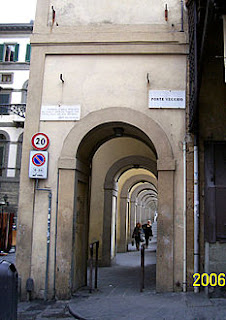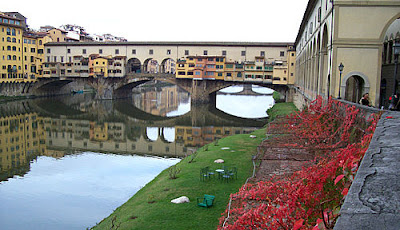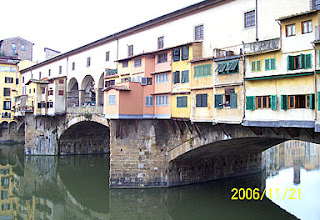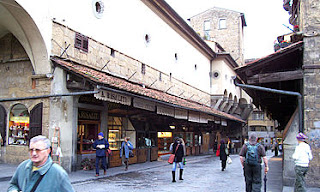
On Tuesday morning of 21 November 2006 we once again took to the streets and walked from the hotel all the way to the New Market and beyond, to where one gains access to the walkway that leads onto the Ponte Vecchio. Our photographs are arranged here in the order in which we encountered the views as we walked along towards and onto the bridge.

Note the beautiful red autumn colours on the leaves of the vines growing on the bank of the river. Although it was already winter, the weather has been so mild that the deciduous plants were late in dropping their leaves.

The Ponte Vecchio (Italian for "Old Bridge") is a famous medieval bridge over the Arno River, noted for having shops (mainly jewellers) built along it. It is Europe's oldest segmental arch bridge.

This view is of the Arno looking back in the direction from where we came, with the Ponte alle Grazie in the distance.
Believed to have been first built in Roman times, the Ponte Vecchio was originally made of wood. After being destroyed by a flood in 1333 it was rebuilt in 1345, this time in stone.

This view of the river Arno is taken from the Ponte Vecchio, with two other bridges visible in the distance. The first is the Ponte Santa Trinita and the second is the Ponte alla Carraia.
Most of the design of the Ponte Vecchio is attributed to Taddeo Gaddi. The bridge consists of three segmental arches, the main arch has a span of 30 meters and the two side arches each span 27 meters. The rise of the arches is between 3.5 and 4.4 meters.

The Ponte Vecchio has always hosted shops (legend says this was originally due to a tax exemption) and the merchants displayed their goods on tables after obtaining authorisation from the Bargello (a sort of a lord mayor, magistrate and police authority).
It is said that the economic concept of bankruptcy originated here. When a merchant could not pay his debts, the table (banco) on which he sold his wares was physically broken (rotto) by soldiers, and this practice was called "bancorotto" (broken table). Not having a table anymore, the merchant was not able to sell anything.
In order to connect the Palazzo Vecchio (Florence's town hall) with the Palazzo Pitti, Cosimo I de Medici had Giorgio Vasari build the famous "Vasari corridor" above it in 1565. To enforce the prestige of the bridge, in 1593 he prohibited butchers from selling their goods there, and their place was immediately taken by gold merchants. The association of butchers had monopolised the shops on the bridge since 1442.
During World War II, the Ponte Vecchio was not destroyed by Germans during their retreat in 1944, unlike all other bridges in Florence. This was allegedly because of an express order by Hitler.

This statue of Cellini stands guard at the one end of the Ponte Vecchio. Benvenuto Cellini (1500-1571) was an Italian goldsmith, painter, sculptor, soldier and musician of the Renaissance. Remember, we saw his statue of Perseus with the Head of Medusa in the Loggia dei Lanzi earlier on.
In a recent tradition for the Ponte Vecchio, many padlocks were locked to various places on the bridge, especially to the railing around the statue of Cellini. The custom was perhaps introduced by the padlock shop owner at the end of the bridge. It is popularly connected to the idea of love and lovers: by locking the padlock and throwing the key into the river, the lovers became eternally bonded.
This is an example of the negative impact of the mass tourism (thousands of padlocks needed to be removed frequently, spoiling or damaging the structure of the centuries-old bridge). However, it seems to have decreased after the city administration put a sign on the bridge warning of a 50 Euro penalty for those caught locking something to the fence.

1 comment:
Nice post and this fill someone in on helped me alot in my college assignement. Say thank you you for your information.
Post a Comment